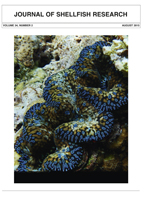Abalone are enigmatic, displaying subtle responses to stress, including a delayed onset of morbidity, and death after severe stress. The present study therefore sought to further elucidate the nature of stress responses in the blackfoot abalone Haliotis iris and develop practical indices to quantify stress and forecast survival. Abalone were challenged with air exposure (16°C, 4–120 h). Physiological responses were assessed at three organizational levels: whole organism (heart rate), extracellular (hemolymph metal concentrations), and intracellular (hemocyte lysosome stability). Hemolymph sodium:potassium ratio showed a strong negative correlation with emersion time (R2 = 0.82) and a reasonable capacity to predict subsequent survival (R2 = 0.50); a [Na]:[K] of 23 was representative of an undisturbed abalone, whereas values less than 15 typically indicated morbidity. Hemocytes tended to lyse before lysosome destabilization could be quantified by neutral red loss; the stability assay therefore failed to yield meaningful data. Resting heart rate declined from 19.4 min-1 (undisturbed) to a minimum of 1 min-1 recorded after 48 h emersion; however, the correlation between heart rate and emersion time or subsequent survival was weak. Hemolymph sodium:potassium ratio warrants further investigation as a practical and sensitive forensic tool to quantify stress, but will require complementary approaches to robustly determine the survival tipping point.
How to translate text using browser tools
1 August 2015
Physiological Indicators of Stress and Morbidity in Commercially Handled Abalone Haliotis iris
Norman L. C. Ragg,
Ellie Watts
ACCESS THE FULL ARTICLE

Journal of Shellfish Research
Vol. 34 • No. 2
August 2015
Vol. 34 • No. 2
August 2015
Abalone
fishing stress
Haliotis iris
heart rate
hemolymph
morbidity
neutral red retention assay




